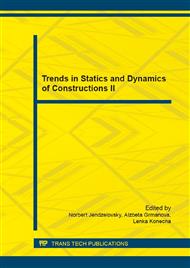p.89
p.94
p.99
p.103
p.109
p.113
p.121
p.127
p.131
Microstructure of Unburned Clay and its Shrinkage during Drying
Abstract:
Unburned clay was used for the traditional engineering works for thousands years. Its qualities have not been too appreciated in the last few decades. Because of that, its material characteristics were never researched very rigorously. In last years, we could see increasing demand for use of this building material in building practice and research. The basic problem that should be mitigated by civil engineers handling unburned clay is its considerable shrinkage during drying. The degree of shrinkage depends on the amount of mixture water and on the amount and type of clay minerals. In the unburned clay, like in the cement, clay minerals play role of the binder. The problem is that clay minerals are causing volume changes. This paper is focused on the degree of shrinkage and its dependence on the species and quantity of clay mineral.
Info:
Periodical:
Pages:
109-112
Citation:
Online since:
June 2016
Authors:
Keywords:
Price:
Сopyright:
© 2016 Trans Tech Publications Ltd. All Rights Reserved
Share:
Citation:


